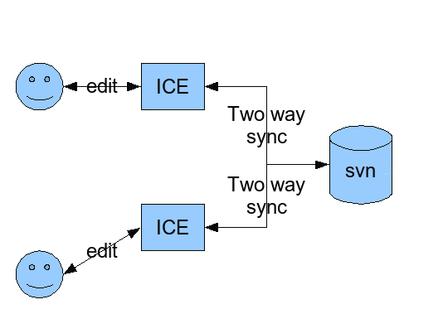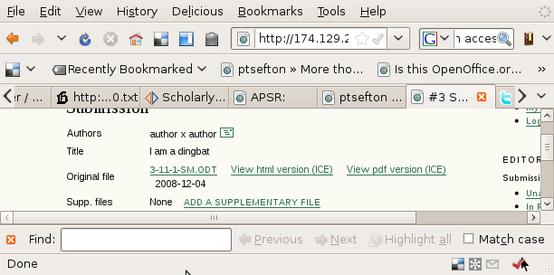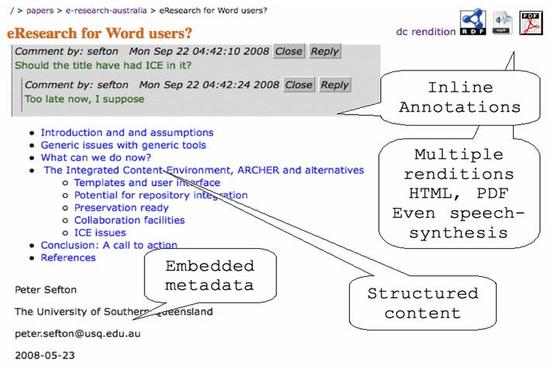Scholarly Publishing using the Integrated Content Environment
2008-12-11
2008-12-11
University of Southern Queensland
1 Orientation
This is another blog post based on a presentation. What I've been doing lately is working on each presentation as a document with embedded slides before I give it. I think that working this way makes for a more coherent delivery and I can take a bit of time to edit the thing into something a bit more useful than a PowerPoint presentation*. Of course it's only ever half done by the time I give the talk so I have to come back and finish it off and edit to make it reflect what I think I actually said.
Here's the notes for my talk at the recent Open Access Publishing workshop run by APSR. The website bills it as “A two-day Public Knowledge Project Workshop”, while the program says it was a “a PKP User Group Workshop”, either way the idea was to talk about issues around the mission of and the software produced by the PKP project. Website says:
The Public Knowledge Project is a research and development initiative directed toward improving the scholarly and public quality of academic research through the development of innovative online publishing and knowledge-sharing environments. More...
This was the last APSR event and I'd like to take the opportunity to say thanks to the APSR crew, particularly Margaret Henty for all the APSR events of various kinds over the last few years. These events got us started in the repository business, APSR events helped bootstrap the RUBRIC project.
I started with this abstract:
Abstract: The Integrated Content Environment (ICE) is an open source software application and service-platform for word processor based academic authoring, originally built to support the University of Southern Queensland's flexible-delivery courseware but now expanding into more general scholarly publishing.
We will show a myriad of ways that ICE can be used in the academy. Starting from document creation, ICE uses generic word processing templates which capture the structure and semantics of scholarly documents. The system manages collaborative works in progress using a distributed version-controlled repository, and can publish works to HTML, PDF and domain-specific XML schemas. It has been integrated with several other systems, including the Moodle Learning Management System and DSpace, ePrints and Fedora repositories.
Specific examples will include an journal which uses the ICE publishing system, demonstrations of semantic-web publishing for theses (an outcome of the JISC-TheOREM ICE project) and institutional repository integration.
2 Introduction
The Integrated Content Environment (ICE) is an open source software application and service-platform for word processor based academic authoring, originally built to support the University of Southern Queensland's (USQ's) flexible-delivery courseware but now expanding into more general scholarly publishing.
ICE is a product of a software development team now located in the Australian Digital Futures Institute (ADFI) at USQ. The Institute is involved in a research and development projects in eLearning and eResearch.
When I first wrote up this talk, I thought it might come out a bit negative. I had this paragraph:
This presentation I will show-off ICE and talk about how some of its modules can be used in and mashed-up with other systems. Unfortunately, the conclusion to this presentation is not “and they all lived happily ever after”. After showing some of what ICE can do, a lot of which I believe is very important to the scholarly enterprise, I will go on to talk about the challenges that lie ahead. All we have to do is change the entire scholarly publishing model and along the way make our publishing systems much more flexible and far reaching.
But actually, the tone of the meeting made it a bit hard to summon the doom and gloom. We had a very productive exchange on how we might mesh our technologies and experience with the PKP systems.
3 About ICE
I kicked off with some credits. ICE is a team effort, I make the most noise but I don't do the most work.
ICE is more than one thing. See the website.
The templates are at the heart of the ICE system. They provide a simple generic way to structure word processing documents. It is well known, if not a scientifically documented fact, that using a word processor to create web pages typically results in, shall we say sub-optimal web sites.
ICE is style-driven, not as in fashion conscious, but as in styles-as-named-bundles of-formatting which have structural or semantic significance.
To convert word processing documents to HTML and PDF ICE uses OpenOffice.org. ICE converts Word documents to the OpenDocument Format behind the scenes, a step which is not necessary with OOo Writer. And from there there's code to turn ODF into HTML. ICE uses Writer to generate web-ready images from the various graphic formats, equations etc.
ICE can be used in lots of ways. It started life as a courseware authoring system. At USQ we have a decades-long tradition of producing printed distance education materials, and for the last decade or so of making the same content available on the web, with added webbish goodness.
Starting from document creation, ICE uses generic word processing templates which capture the structure and semantics of scholarly documents. The system manages collaborative works in progress using a distributed version-controlled repository, and can publish works to HTML, PDF and domain-specific XML schemas. It has been integrated with several other systems, including the Moodle Learning Management System and DSpace, ePrints and Fedora repositories.
While ICE can be used to manage thesis drafting it doesn't really manage the other processes that go on, Particularlty the examination process where PKP's Open Journal Systems (OJS) might help – OJS is used at USQ to manage the thesis review process for some theses.
Speaking of journal systems I showed an example of journal which was published using the ICE publishing system:
There's very little overlap between ICE and OJS.
I was able to demonstrate some work that Linda Octalina has been doing to integrate ICE conversion services into OJS. She's added a basic feature where you can upload an ICE document and instead of treating is as a monolithic word processing file, OJS fires it off to ICE to be converted into other formats, and then shows them to you:
In the above screenshot you can see how OJS now has an HTML and PDF rendition for each file, If we could make this work then OJS would be able to use ICE features like embedding data such aschemistry or inline annotations. Here's a screenshot that covers a few ICE features:
The final point above, about a generic structured document profile seemed to resonate with MJ Suhonos from PKP. We've corresponded for a while about getting ICE and his Lemon8-XML project better aligned. Now that we've met s and had a couple of glasses of wine that should be a bit easier.
If MJ decides to use ODF we'll be there to help with the process of getting the Open Document Format word processing format (ODT) plugged into Lemon8-XML as a back-end, a byproduct of which will be what I was hoping for in my previous post, a way to bring unstructured documents into the ICE fold.
* As I always say a used PowerPoint (particularly without speaker notes) is about as much use as a used condom. Fun for those who were there, maybe, but lacking appeal for those who were not.



